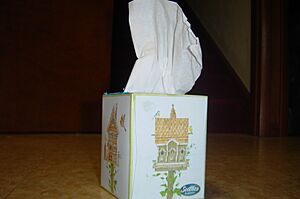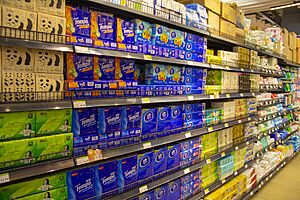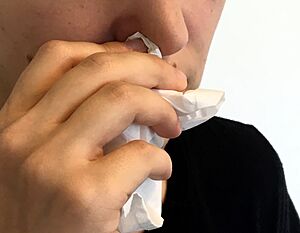Facial tissue facts for kids
Have you ever had a runny nose and reached for a soft, disposable paper? That's a facial tissue! These soft, absorbent papers are made for your face. They are a handy, one-time-use choice instead of cloth handkerchiefs. Most often, when we say "tissues," we mean the kind that come in a box, perfect for blowing your nose. In some places like Canada and the United States, people often call all facial tissues "Kleenex" because that brand became very popular.
How Are Tissues Made?
Facial tissues are made from a special kind of very thin paper. This paper is usually made from pure wood pulp. Sometimes, recycled paper fibers are also added. To make tissues extra soft, they often go through a process called "calendering." This makes their surface smooth.
Most tissues have two or three layers, called "plies." This makes them stronger and more absorbent. Manufacturers often add special ingredients to tissues. These can include softeners to make them feel gentle on your skin. Some tissues even have lotions or a light perfume for a pleasant smell. After they are made, the tissues are carefully folded. Then, they are placed into small, pocket-sized packs or larger boxes for you to use.
The Story of Tissues
Did you know that people have used facial tissues for a very long time? In Japan, for centuries, a special paper called washi (和紙) was used. A European traveler in the 1600s wrote about how the Japanese used soft, silky papers to blow their noses. They would use them once and then throw them away.
Kleenex: From Makeup to Noses
The facial tissues we know today first appeared in 1924. A company called Kimberly-Clark introduced them as Kleenex. At first, Kleenex was made to help people remove cold cream and makeup. Famous movie stars like Helen Hayes and Jean Harlow even helped advertise them! They showed how Kleenex could gently take off their stage makeup.
But something interesting happened. People started using Kleenex for other things, especially for blowing their noses. By 1926, a newspaper survey found that many people were using Kleenex as a disposable handkerchief. This showed how useful tissues were for everyday needs. Over time, Kimberly-Clark also created new types of tissues. These included pop-up tissues, colored tissues, and even tissues with fun designs.
See Also




